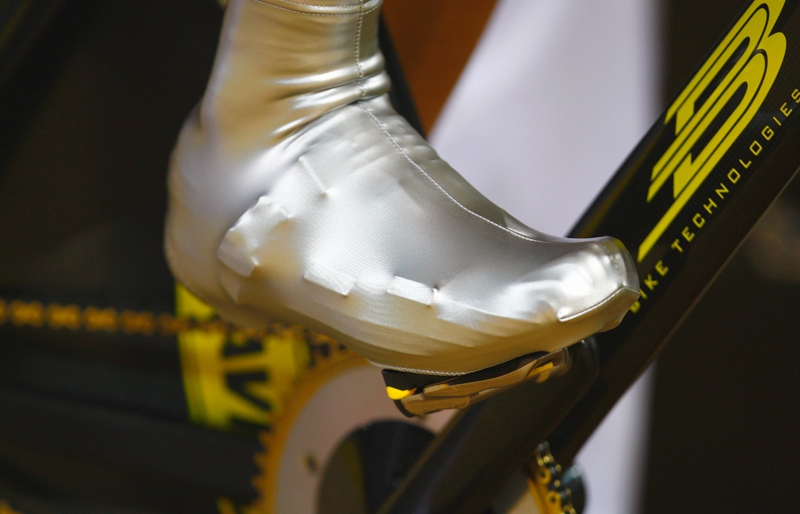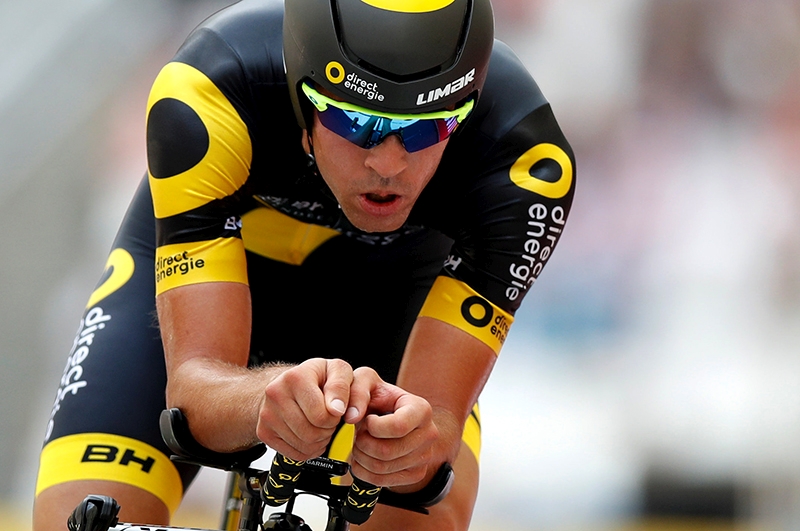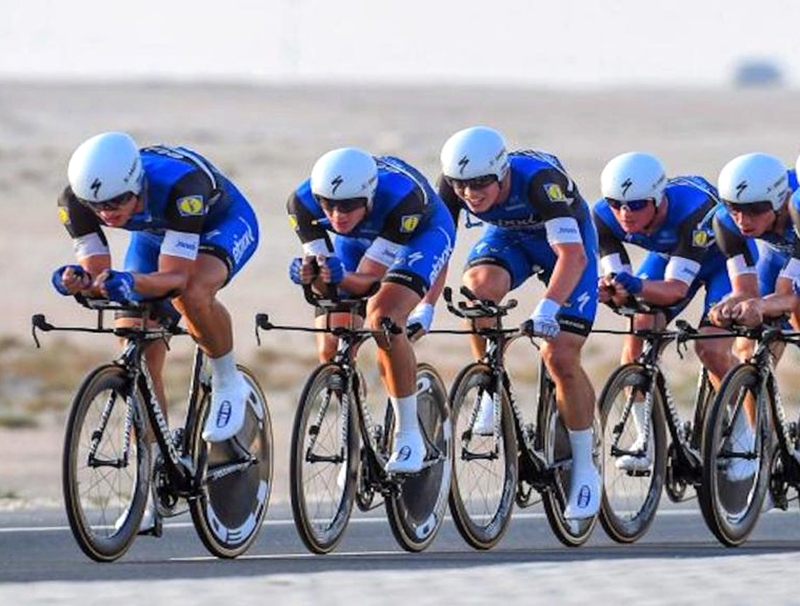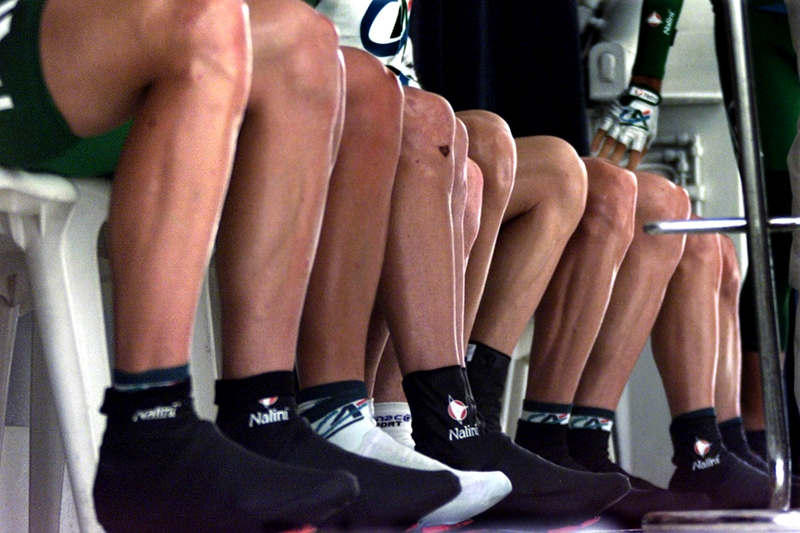You are viewing 1 of your 1 free articles. For unlimited access take a risk-free trial
In a spin: what all cyclists should know about pedalling cadence

The optimum pedalling cadence – how fast you spin the cranks – for maximising cycling efficiency and performance is a subject that has long occupied sports scientists. Andrew Hamilton looks at recent research in this area and provides some practical recommendations for cyclists...
Observing top riders in an event like the Tour de France, it soon becomes apparent that pro cyclists are very different from mere mortals – even very fit club cyclists. The most obvious difference is just how fit these guys are. During a long climb in the mountains, a top rider can sustain the kind of power output for 10s of minutes that many cyclists would be unable to achieve in a 10-second sprint!
Another observation is pedalling technique; as well as being very smooth, many pro riders spin the pedals relatively rapidly compared to most recreational cyclists. A good example of this is (the now disgraced) Lance Armstrong, whose typical pedalling cadence was in the region of 95-100rpm. This compares with a more typical 80rpm for the average club rider, and even lower pedalling speeds for less seasoned cyclists.
Cadence and efficiency
You might think that a sure-fire route to improving your cycling performance is to up your pedalling cadence, but (as with so many things in life) the reality is never that simple. It’s true that pro cyclists typically spin the cranks at 90-100rpm; however they are very different animals to most of us. A major difference is that an elite pro rider can sustain continual power outputs in excess of 400 watts for periods of 20 minutes up to as long as an hour(1,2) (see box 1 for some data on Miguel Indurain).Box 1: The power of Indurain

In a 2012 paper, scientists from the USP Araba Sport Clinic in Spain studied the 5-time Tour de France winner and Olympic Champion Miguel Indurain some 14 years after his retirement from professional cycling(1). As part of this study, they gathered data from his racing years – data that makes impressive reading.
In race condition, Indurian’s aerobic capacity enabled him to transport around 7 litres of oxygen around his body per minute – this compares to 3–4 litres for an untrained person and 5–6 litres for most elite riders. His maximum cardiac output was measured at 50 litres a minute (a fit recreational athlete’s would be about 25 litres per minute) while his maximum oxygen uptake capacity was reputed to be around 88ml/kg/min - in comparison, Lance Armstrong's was ‘only’ 83.8 ml/kg/min! This combination of physiological strengths endowed Indurain with a tremendous maximum sustainable power – around 450 watts!
A well-trained club rider might be able to sustain 250-300 watts, which is at best only two thirds of Indurain’s sustainable power. Comparing forces at the cranks, sustaining 450 watts at 100rpm requires more force per revolution than does 300 watts at 70rpm. Therefore, when Indurain was spinning the cranks at 100rpm during a sustained effort, he was applying more force each crank revolution than would a well-trained club cyclist pushing as hard as he/she could up a hill at just 70rpm despite spinning the cranks 50% faster! This explains why the pros can spin fast and efficiently – even though they’re spinning fast, they’re still applying lots of force through the pedal. Amateur riders who pedal at 100rpm on the other hand won’t be able to generate enough force to make that pedalling cadence efficient (as we’ll see shortly).
Power, force and cadence
The relationship between force applied to the pedal, power output and gross efficiency (how much chemical energy the muscles use to produce a given power output) has long been a topic of great interest to sports scientists. The reason is simple: if certain pedalling cadences are energetically more favourable at given power outputs, then by choosing the right pedalling cadence, a cyclist can work more efficiently – ie, go faster for the same power output or reduce energy costs for a chosen speed.It’s also important to understand that optimum pedalling cadences may vary greatly depending on the circumstances. As we’ll see shortly, at low power outputs – eg during prolonged sub-maximal cycling - gross efficiency (GE) is higher at relatively low rpm. At very high power outputs – eg during maximum effort time trials and sprints for example – it may be desirable or even necessary to raise your pedalling cadence well beyond that required for optimum efficiency.
A review study by Australian researchers looked at this study in more detail(3). It concluded that relatively high pedalling cadences (100-120rpm) can improve sprint cycling performance, since cycling power output is maximised at such pedal rates thanks to reduced peak muscle forces and neuromuscular fatigue (see figure 1). However, because extremely high cadences increase the metabolic cost of cycling (ie lower gross efficiency), prolonged cycling (eg longer time trials) may benefit from a slightly reduced cadence or around 90-100rpm.
Figure 1: Relationship between peak torque, peak power and pedalling cadence(3)

Dotted and solid lines represent data from two different subjects. Notice that although peak torque (turning force) is made at low rpms, maximum power is made in the region of 110-120rpm
The researchers also concluded that during ultra-endurance cycling events (over 4 hours duration), performance might be improved through the use of a relatively low cadence of 70-90rpm, because these lower cadences favour improved cycling economy and lower energy demands. However, they added the caveat that lower cadences increase the pedal forces necessary to maintain a given power output; since the generation of high force makes more demands on the muscles’ glycogen reserves, this could mean faster glycogen usage, which in turn could makes it more difficult to sustain higher power outputs as glycogen reserves become progressively depleted.
Cadence and efficiency
As mentioned above, using too high a cadence during prolonged cycling appears to be counterproductive because it can lower GE. Scientists from the University of California looked into the relationship between GE and cadence(4). They investigated whether the use of high cadences, during a prolonged cycling protocol with varying intensities (similar to race conditions) decreased performance compared to cycling at a lower cadence, where the benefits of improved GE might be apparent.Eight healthy, competitive male road cyclists cycled for 180 minutes at either 80 or 100rpm with varying intensities of power outputs, which corresponded to 50% (easy intensity), 65% (easy to moderate intensity) and 80% (fairly hard intensity) of the cyclists’ maximum aerobic capacity (VO2max). At the end of this 3-hour cycling period, the cyclists then completed a ramped exercise test to exhaustion at their preferred cadence, which ranged from around 83rpm to 97rpm. During the trials, the researchers monitored a number of aspects of the cyclists’ performance, including heart rates, oxygen consumption and the amount of blood lactate present (a useful marker of muscular fatigue).
Table 1: Difference between 80rpm and 100rpm during prolonged sub-maximal cycling

The results are summarised in table 1 above. Before we look at the findings, remember that the power outputs during the cycling were exactly matched regardless of cadence, so any differences were due to the different efficiencies at different cadences. Firstly, look at oxygen consumption and you can see that at both 65% and 85% VO2max, the cyclists needed to consume more oxygen to sustain 223 and 292 watts respectively when pedalling at 100rpm. This was paralleled by energy expenditure; at 65% VO2max (223 watts), the cyclists energy output was 15.2Kcals per minute when pedalling at 100rpm but only 14.3Kcals per minute while pedalling at 80rpm. At 80% VO2max, the figures were 19.1 and 18.3Kcals per minute respectively. In other words, the cyclists were simply more efficient at producing the power needed when they pedalled at 80rpm compared to 100rpm. For example, at 80% VO2max, the cyclists’ GE averaged 22.1% when they pedalled at 100rpm. At 80rpm, GE was higher (23.1%) indicating that the cyclists were converting chemical energy in the muscles into power to spin the cranks significantly more effectively.
Higher efficiency means less oxygen is needed by the muscles, which in turn means the muscles will produce less lactate at a given power output – and this is exactly what the blood lactate figures show; during the 3-hour exercise period at the higher power output (80% VO2max), average blood lactate concentrations were 18.8% greater at 100rpm cadence than those seen at the 80 rpm cadence. Lower lactate equate to lower levels of fatigue, which again is borne out by the results. The RPE was significantly lower at 80% VO2max when pedalling at 80rpm compared to 100rpm (6.5 vs. 6.8). Moreover, in the maximal power till exhaustion test, the cyclists averaged 362 watts while pedalling at 80rpm but only 327 watts when pedalling at 100rpm (see figure 2).
Figure 2: Effects of cycling cadence on maximal power during exercise to exhaustion

How do these findings fit with the observation that many pro cyclists typically spin the cranks at well over 90rpm? Some previous studies in this area have indicated that competitive cyclists should employ a lower cadence than is generally seen in the field(5,6). However, many of the laboratory investigations into cadence effects were typically conducted using short bouts of exercise (6-30 minutes) at constant external power outputs – ie quite different conditions to that found in an actual race situation. The recent study above(4) however used a prolonged cycling trial, consisting of repetitive high intensity efforts interspersed with lower-intensity work – much more representative of real race conditions.
Summing up, the authors concluded that “Given that gross efficiency was lower at 100 rpm compared to 80 rpm, and that maximal power output during the ramped protocol to exhaustion was greater at 80rpm, it appears that the use of a high cadence during low to moderate workloads is not economical and may compromise performance during prolonged cycling.” In other words, when you’re not working flat out all the time, a very high cadence of around 100rpm is not only unnecessary, it’s also counterproductive.
Freedom of choice
Does a freely chosen cadence tend to work for or against a cyclist? As we saw earlier, in a maximal power/sprint situation, the choice of a high cadence is not just desirable but necessary. However, in sub-maximal efforts, cyclists may instinctively select a cadence which is too high. A 2009 paper reviewed and summarised the factors affecting cadence choice by cyclists(7). It found that a number of factors, including age, power output, and road gradient, can all affect the choice of cadence – at least to some extent. During high-intensity cycling, close to the maximal aerobic power output, the researchers concluded that cyclists tend to choose an energetically economical cadence that is also favourable for performance. In contrast however, many cyclists may choose a relatively high cadence during cycling at low-to-moderate intensity, which is uneconomical and could compromise performance during prolonged cycling – ie in agreement with the US study above.Why should this be the case? After all, in many sporting situations, the brain is very successful at generating the most efficient muscle movement patterns possible. The most plausible explanation is that rhythmic, repetitive movement is controlled to a much larger extent by the central nervous system (via ‘central pattern generators’) than it is by sensory feedback. This seems to be supported by the fact that freely chosen cadence is not mirrored by increases in the load on the cardiorespiratory system. In other words, you are likely to sustain a given cadence across a wide range of workloads, which suggests that cadence choice represents an ‘innate voluntary motor rhythm’(8). That your freely chosen cadence is strongly affected by rhythm during exercise is not surprising as a large amount of recent research has shown that music (particularly music with a strong rhythm) can influence (and enhance) exercise performance by reducing the perception of fatigue(9).
The good news however is that research indicates many (but not all) experienced cyclists do seem able to self select a pedalling cadence that isn’t too far from optimum. In a 2012 study, researchers assembled a group of experienced cyclists and while pedalling at a constant power, measured blood lactate levels to determine the best cadence for minimising lactate (and therefore fatigue)(10). They then asked them to pedal at their preferred cadence to see how close this was to the cadence that had resulted in the minimum lactate measurement. It turned out that the many of the cyclists self-selected a cadence that was within a few rpm of optimum cadence. Some caution is required however, as whether this close correlation would be maintained across a wider range of power outputs, was not tested. Also, the cadence at which gross efficiency is maximised is not necessarily the same where lactate production is minimised.
Cadence and hills
Love them or hate them, hills have a big impact on cyclists. This is because (compared to say walking or even running), the typical speeds during cycling are high. This means that when pedalling on the flat then hitting an incline, the rate of climbing is fairly fast – even on a gentle gradient. Unless a large amount of extra power can be generated during (unlikely if the cyclist is already working at anything other than a gentle intensity), the cyclist will have to slow considerably. Then of course, the cyclist also has to do additional work to lift the weight of the bike as well as his/her body!Given the sudden and large change in cycling speeds and/or power output when tackling a hill, it’s not surprising that optimising cadence is the topic of much debate among cyclists. Should you get out of the saddle and grind away or (if the gearing allows) sit back and spin away? Studies and field observations of cyclists have revealed that when cycling uphill, cyclists tend to select a lower cadence and also adopt a more upright body position, but is this the correct strategy?
One study examined the effect of incline on cadence by comparing road cycling on the level (0%) with an incline of 7%(11). Eighteen experienced cyclists were tested at both inclines and while either sitting upright or riding low on the drop handlebars. The researchers measured the cyclists’ maximum sustainable power and the levels of lactate produced at a given power output. The results showed that compared to cycling on the flat, cycling uphill required a lower cadence and a more upright body position to maximise power while minimising lactate and to increase pedalling efficiency.
Another study investigated the effect of gradient on cycling gross efficiency and pedalling technique(12). Eighteen trained cyclists were tested for gross efficiency, distribution of power production during the pedal revolution (dead centre size – the topmost part of the pedal revolution where little force is generated) and timing/level of muscle activity of eight leg muscles. Cycling was performed on a treadmill at gradients of 0% (level), 4%, and 8%, each at three different cadences (60, 75, and 90rpm). It found that gross efficiency was significantly decreased at a gradient of 8% compared with both 0% and 4%. However, this effect was observed regardless of the cadence used. This was probably explained by the fact that when cycling at the 8% gradient, the onset of muscle activity for the vastus lateralis and vastus medialis muscles (frontal thigh) and the gastrocnemius lateralis and gastrocnemius medialis muscles (calf) occurred significantly earlier. More muscle activity helps to generate larger amounts of force in contracting muscle tissue but more fibres contracting also means more internal energy losses, which lowers gross efficiency.
A further study examined the relationship between pedalling technique and gross efficiency in 10 well-trained cyclists who cycled at work rate corresponding to 75% of their maximum oxygen uptake (moderate-hard intensity)(13). The study compared level and incline (11%) cycling, and also the effects of adjusting the seat forward and backward (see figure 3) and using three different cadences – each cyclist’s freely chosen cadence, a cadence that was 10rpm slower and one that was 10rpm faster. In all the subjects, as the cadence increased, gross efficiency fell regardless of incline, indicating that the cyclist’s natural chosen cadence wasn’t necessarily the most efficient. The actual gradient didn’t affect gross efficiency however, and neither did the seat position.
Taking all these results as a whole, we can conclude that:
- *The relationship between cadence and gross efficiency appears to be unchanged when cycling uphill – ie, lower cadences are likely to be more efficient and thus save energy in the longer run;
- *Despite this, the greater forces needed to cycle uphill means that while a lower cadence may be more energetically efficient, it might result in more lactate accumulation. Given that (on longer climbs), a significant accumulation of lactate will slow the cyclist significantly and may even force him/her to stop, losing a little efficiency by using a higher cadence (which reduces the forces on muscle fibres) is a price worth paying;
- *The cyclist’s body position during seated climbing doesn’t appear to affect efficiency but a more upright stance might help lower lactate accumulation.
Figure 3: Gross efficiency, incline and seat position(13)

In addition to varying the gradient, the cyclists were studied riding on the flat (A), on an incline (B) and with the seat forward and backward from the cyclists’ preferred position (C).
Training your GE
Recent studies suggest that for sub-maximal cycling, a cadence of around 80rpm is preferable to the 85-90+rpm employed by many cyclists because it results in higher gross efficiency, meaning that more power on the bike can be produced for less energy expenditure by the muscles. So why don’t all cyclists pedal at 80rpm or below? Putting aside the issue of an innate rhythm, another reason is that (as we’ve already alluded to), a low cadence requires a higher turning force (torque) to sustain power output, and that extra torque might be enough to produce higher levels of lactate, resulting in more fatigue.A useful question to ask therefore is whether there is another proven strategy to increase your gross efficiency? One answer could be strength training. Back in 2005, scientists in New Zealand studied the effects of explosive training and very high intensity cycling sprints on endurance and sprint performance in 18 cyclists(14). The cyclists were assigned to an experimental or control group for 5 weeks of training. The experimental group replaced part of their usual cycling training with twelve 30-minute sessions consisting of three sets of explosive single-leg jumps, alternating with three sets of high-resistance cycling sprints; the control group meanwhile simply maintained their normal cycling training. Compared to the control group, the riders in the strength/sprinting group showed dramatic increases in power and endurance capacity. However, what particularly surprised the researchers was that the strength/sprint training improved gross efficiency – an aspect of performance that most scientists had previously thought could only respond to extended endurance training.
More recently, Norwegian researchers took sixteen competitive road cyclists and randomly assigned them into two groups(15):
- An intervention group who performed half-squats, four sets of 4 repetitions maximum, 3 times per week for eight weeks, as a supplement to their normal endurance training.
- A control group who continued their normal cycling training during the same period with no strength training.
Summary and conclusions
When it comes to cadence, faster isn’t necessarily better. Although the elite pros tend to employ high cadences, for most cyclists, high cadences of 90-100rpm may only be beneficial during flat out efforts such as sprints and short time trials. At other times, lower cadences nearer to 80rpm may confer an advantage by increasing efficiency, resulting in less muscular energy consumed per watt produced on the bike. During harder efforts (for example climbing), the optimal cadence for efficiency may be less than required to minimise lactate accumulation. In these circumstances, it may be advantageous to sacrifice some efficiency by raising cadence and keep lactate under control. Regardless of cycling fitness, recent evidence suggests that lower body strength training is an effective method of raising gross efficiency. Not only does it raise gross efficiency in its own right, it may also allow cyclists to employ lower pedalling cadences to further increase efficiency without paying a ‘lactate penalty’!References
- Int J Sports Physiol Perform. 2012 Dec;7(4):397-400
- J. Appl. Physiol 2005; 98:2191-2196
- Med Sci Sports Exerc 2000; 32(7): 1281-1287
- Journal of Sports Science and Medicine (2014) 13, 114-119
- Acta Physiologica Scandinavia 2002; 176(3), 185-194
- J Appl Physiology 1975; 38(6), 1132-1139
- Int J Sports Physiol Perform. 2009 Mar;4(1):3-17
- Experimental Brain Research 2008; 186(3),365-373.
- Int Rev Sport Exerc Psychol. 2012 Mar;5(1):44-66
- Int J Sports Physiol Perform. 2012 Dec;7(4):375-81
- Eur J Appl Physiol. 2012 Jul;112(7):2433-41
- Med Sci Sports Exerc. 2013 May;45(5):920-6
- Eur J Appl Physiol (2011) 111:2885–2893
- J Strength Cond Res. 2005 Nov;19(4):826-30
- J Strength Cond Res. 2010 Aug;24(8):2157-65
- Int J Sports Med. 2009 Jan;30(1):27-32
- Scand J Med Sci Sports. 2011 Apr;21(2):250-9
Newsletter Sign Up
Testimonials
Dr. Alexandra Fandetti-Robin, Back & Body Chiropractic
Elspeth Cowell MSCh DpodM SRCh HCPC reg
William Hunter, Nuffield Health
Newsletter Sign Up
Coaches Testimonials
Dr. Alexandra Fandetti-Robin, Back & Body Chiropractic
Elspeth Cowell MSCh DpodM SRCh HCPC reg
William Hunter, Nuffield Health
Keep up with latest sports science research and apply it to maximize performance
Today you have the chance to join a group of athletes, and sports coaches/trainers who all have something special in common...
They use the latest research to improve performance for themselves and their clients - both athletes and sports teams - with help from global specialists in the fields of sports science, sports medicine and sports psychology.
They do this by reading Sports Performance Bulletin, an easy-to-digest but serious-minded journal dedicated to high performance sports. SPB offers a wealth of information and insight into the latest research, in an easily-accessible and understood format, along with a wealth of practical recommendations.
*includes 3 coaching manuals
Get Inspired
All the latest techniques and approaches
Sports Performance Bulletin helps dedicated endurance athletes improve their performance. Sense-checking the latest sports science research, and sourcing evidence and case studies to support findings, Sports Performance Bulletin turns proven insights into easily digestible practical advice. Supporting athletes, coaches and professionals who wish to ensure their guidance and programmes are kept right up to date and based on credible science.













